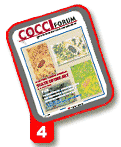Special Report
International conference maps future direction for control
The tropical far north of Queensland, Australia, seems a world
removed from broiler houses or research labs, but in July 2001
it was the gathering place for some of the best scientific minds
in the business.
The 8th International Coccidiosis Conference, sponsored by the
Australian Society for Parasitology, was attended by some of the
world's foremost parasitologists. It was a truly international
gathering. As well as the strong contingents from the United
States and host Australia, there were visitors from the U.K. and
Europe, Brazil, South Africa, Japan, China, New Zealand and
many others.
And despite such a diverse grouping, some strong themes
emerged. It revealed that efforts to meet the challenge of one
of poultry's major health problems are "like many things -
becoming globalized. Issues that affect the large-scale broiler
producer in Georgia or North Carolina can be just as pertinent for
a low-tech operation in the south of China.
For people in the poultry industry, the scientists offered a fascinating
window into the future management of coccidiosis. In this
overview of the conference presentations and discussions,
CocciForum takes a look at some of these themes and trends
from the Cairns gathering.
COCCIDIOSIS: TRULY A GLOBAL ISSUE
Compared with some other internal
parasites, the Eimeria
species in poultry are remarkably
stable. Although there may be
variability in the pathogenicity of the
different species, the sudden appearance
of 'hot' new strains seen with
avian viruses is not usually an issue for
the industry.
This could lead to the mistaken conclusion
that with such a stable target
like coccidiosis, control is simply a matter
of finding a management system
that works and sticking with it.
Nothing could be further from the
truth. There are many "drivers" of
change in the industry and a range of
these fall outside the direct control of
producers and animal health specialists.
For example:
|
Gene technology promises benefits, but "� |
Fear about the transfer of antibiotic resistance to the arena of human health is emerging as another major issue for consumers. Vaccination provides the industry with a sustainable, consumerfriendly strategy.
"� Economics The economics of production have a profound impact on animal health management, especially in such an intensive environment as broiler production. This involves not only in-house factors "feed or animal health costs, for instance "but also external forces such as market conditions. While niche markets are developing for premium "drug-free" poultry products, there are also strong pressures to minimize production costs to keep them priced competitively.
"� Technology Rapid advances in biotechnology are providing new insights into Eimeria species "what's out in the field, how they respond to different control measures, and how they interact with their host. New diagnostic techniques featuring DNA analysis are giving scientists an unprecedented close-up picture of these surprisingly complex organisms. This will help researchers develop more subtle, better targeted control measures, while continuing to improve the effectiveness of existing strategies such as vaccination and, to a lesser extent, new-generation feed additives.
"� Parasite and host Although they are relatively stable organisms, Eimeria species are still traveling down the evolutionary road. As well as evolving to build up resistance to chemical and ionophore treatments, the composition of field populations is also constantly shifting. This happens partly in response to the way they are managed by growers, but there are also very complex relationships that scientists are now just beginning to understand.
The relationship with the host is a very close one. As the genetic codes for the parasite and host are revealed, researchers hope to learn more about genetic factors that control the impact of coccidia on its host (i.e., virulence) or how well the host can resist or tolerate the parasite.
It's also becoming apparent that the interaction between different Eimeria species ingested by one bird can have an impact, as does the presence of other microflora in the gut.
This news probably won't change management practices right now, but it does point the way to the future. By learning more about Eimeria at this molecular level, products such as vaccines can be refined to keep ahead of the evolutionary game.
Chemical Tools
|
Drug resistance unpredictable |
The range of chemical and ionophore
treatments for coccidiosis is unlikely to
be extended. The era of development
that started with the anticoccidial "wonder
drugs" in the 1960s and 70s and
progressed to the more recent
ionophores is virtually complete.
The result? The poultry industry
must learn to extend the lives of these
products as much as possible within the
constraints caused by the increasing
resistance of both coccidia and consumers.
While integrating chemicals and
ionophores with vaccination programs
can extend product life, growers are
also turning their attention back to the
basics of good husbandry.
The cure-all originally offered by
chemical tools cannot be totally relied
upon for control of coccidiosis and
other problems such as necrotic enteritis.
(More than once, poultry scientists
at Cairns commented that today's broiler
stock seem "softer" than their predecessors.
If the shield thrown up by
chemical or ionophore treatments loses
effectiveness, birds seem less able to
deal with challenge from coccidia.)
This is leading growers to refocus
on managing such areas as bird density,
ventilation, moisture and litter "all
factors in the uptake of oocysts by
poultry.
The Search for Alternatives
As cracks start to appear in the longterm
sustainability of traditional coccidiosis
treatments, interest is growing
in some quarters in "organic" treatments
based on plant products. While
the jury is still out on the effectiveness
of these products, they present real difficulties
for regulatory authorities when
it comes to registration and quality
assurance.
This is because they are based on
complex organic compounds and it is
not always clear what components, if
any, have a therapeutic effect.
Vaccination: The Growth Area
In the meantime, vaccination is emerging
as the strong growth area in coccidiosis
management for poultry producers.
This theme resounded continually
throughout the week-long conference
in Cairns.
Dr. Harry Danforth, technology
transfer coordinator with the USDA,
said new vaccines are likely to emerge,
featuring different mixes of Eimeria
species/strains. They will also be developed
to match conditions in different
regions or countries.
"Coccidial vaccines are now well established in Europe, Canada and the
United States, and new products are
being developed in Europe and the
United States as well as Australia," he
said.
"Use of vaccines based on live
oocysts such as Coccivac-B still has
considerable potential for growth."
Danforth's comments were echoed
by Dr. David Chapman of the
University of Arkansas. He said the
development of Paracox-5 in Europe
was just one example of the way vaccines
can be formulated to suit the
needs of a geographic region.
The Next Generation?
There was general agreement at Cairns
that the current generation of coccidiosis
vaccines, which are based on live
oocysts, are highly effective but still on
the lower slopes of a steep growth
curve in poultry industries worldwide.
But scientists are still excited about the
potential for the next generation of vaccines.
The "Next Big Thing" will be subunit,
or recombinant vaccines. Rather
than using live oocysts, they'll be
focused on antigens specific to the parasite
and expressed through a bacterial
vector "E. coli, for example.
Using biotechnology tools, some of
which are still very much in their infancy,
this next generation of vaccines will
be highly targeted and sustainable.
They might be injectable or administered
via a spray cabinet as some products
are now.
However, the next wave of products
is still very much on the research
bench. Danforth said that while there's
no doubt these products will eventually
emerge, there is still much basic
research to be done, including the mapping
of the genome for Eimeria
species.
Once that's done, specific genes
can be targeted for vaccines or drug
therapy.
"It'll be a tough nut to crack," he
said. "Some of the genetic research
being done on other coccidia such as
Toxoplasma and Cryptosporidium will
have spinoffs for work on Eimeria in
poultry."
What Lies Ahead?
If there was a common thread running
through the discussions at Cairns it was:
"It's time to think outside the box."
These are just some of the things that
could be just over the horizon:
"� Changing the basic approach to
Eimeria species by redefining the
host/parasite relationship. Using genetic
modification technology, it may be
possible to create dominant strains that
are easy to manage and have minimal
impact on their host. The logic? Get the
parasite to respond to the poultry
industry's requirements rather than the
reverse situation.
"� Easy-to-use diagnostic kits that can
be used in commercial situations to
"map" the breakdown of Eimeria
species present. Management programs
could then be tailored to suit the specific
populations.
"� Using partially drug-resistant
lines of Eimeria in live vaccines. This
concept appears to fly against conventional
wisdom that a key benefit of vaccines
is that they "reseed" poultry houses
with drug-sensitive strains. Trials
have shown that the drug-sensitive
strains do indeed re-establish on pen
floors after a flock is vaccinated,
although drug resistance seems to subsequently
re-emerge after several growouts
using a drug regime.
The logic behind using drug-resistant
strains in a live vaccine is that it
could allow drug therapies for the control
of drug-sensitive coccidial species
and other organisms (e.g., clostridia) in
tandem with vaccination. (At present
this can't be done with most live oocyst
vaccines, because anticoccidial drugs
would compromise the coccidial strains
used in these vaccines.) It's a radical
concept but there is already one such
vaccine being developed
in Europe.
"� Creating a universal
strain of the
species used in vaccines
to deal effectively
with all field
strains of Eimeria
species. This development,
which would
also grow out of
genetic modification
technology, would
address the challenges
posed by
regional variations in
Eimeria populations.
Talking Coccidiosis
Notes from the Australia Roundtable
Roundtable Participants
Dr. David Chapman, Department of Poultry Science,
University of Arkansas (Chair)
Dr. Tim Cherry, Stephen F. Austin University, Texas
Dr. Harry Danforth, Technology Transfer Coordinator, USDA
Dr. Grant Richards, Eimeria Pty Ltd, Victoria, Australia
Dr. Martin Shirley, Institute for Animal Health, Compton, U.K.
Dr. Ray Williams, Schering-Plough Animal Health, Harefield, U.K.
It was billed as a "controversial roundtable" and was strategically slotted on the last day of the 8th
International Coccidiosis Conference in Queensland, Australia. The focus: The role of live vaccines in
the sustainable control of coccidiosis in poultry production.
Led by some of the heaviest hitters in this branch of poultry science, the roundtable discussion lived up
to its billing and attracted a standing-room-only crowd. Following are CocciForum's notes from
this lively session
Take an Integrated Approach
 Danforth: Proven treatments are emerging.
|
A decision to use vaccination against
coccidiosis isn't a question of 'all-or-nothing'.
While vaccination isn't currently
used in the same flock with chemical
or ionophore treatments, vaccination
can become part of an effective rotational
program,
alternating with
existing medication-
based regimes.
Harry Danforth
gave a graphic
example of how
this works in practice.
He has done
trials that confirmed
how Coccivac-B repopulated
farms
with coccidia that
were sensitive to
salinomycin. This
helps enhance the
usefulness of the drug if it is used in a
later growout.
Watch the Arsenic
Some populations of Eimeria tenella "one of the most significant coccidia species "are becoming very resistant to salinomycin.One way of dealing with this has been to use roxarsone (3-Nitro), an arsenical treatment that's been used since the 1970s and is currently used by around 60% of the U.S. poultry industry.
Danforth said that with increasing concerns about arsenic in the environment, growers' access to this tool may be limited in the future. Proven treatments such as vaccination are emerging as viable alternatives.
|
New drug compounds still face
long road to approval
Two new feed additives recently registered in the United States have taken
8 years to make it from initial submission to final registration. |
Keep Tabs on Coccidia
Two presenters at the roundtable
explained why it is important to understand what's happening in a
flock as the coccidia respond to treatment.
Looking at the numbers of coccidia,
as well as what species they
are, shows how the treatments are
working.
Eimeria populations can be
tracked by measuring how many
oocysts are excreted by the birds. Dr.
Ray Williams said that in medicated
flocks, the oocysts per gram (OPG)
counts can vary a lot, but usually
peak at around week 4 or 5.
Williams also noted that, in these
flocks, the coccidia can peak again
toward the end of the growout after
the medication is withdrawn. This can
indicate that the birds are still susceptible
to the disease, and the prophylaxis
has only suppressed the coccidia
rather than giving immunity.
In vaccinated flocks, there are typically
two peaks in the output of
oocysts, the first occurring usually
between weeks 2 and 4. This happens
as immunity is being established.
The second peak represents a
wild-type challenge around week 4 or
5.
Once the second peak has passed,
the OPG counts drop rapidly "a
good indicator that immunity has
kicked in successfully.
Danforth explained that a new
diagnostic tool developed in Europe
and based on molecular biology
(polymerase chain reaction, or PCR)
shows researchers very accurately
which of the seven Eimeria species
are involved in a flock. This is important
to help design good, targeted
treatments. It also helps monitor
exactly how well different programs
are working.
Team Up with Vaccines
Williams said that because vaccination
is a biological process using live
organisms, growers need to learn to
work as a team with the vaccine to
make sure it delivers maximum effectiveness.
The treatment depends on the
birds successfully excreting a generation
of vaccinal coccidia and then
"recycling" them by picking them up
from the litter. The uptake of coccidia
is part of the build-up of immunity.
To successfully "sporulate" in the
environment, coccidia need the right
balance of oxygen, warmth and moisture.
If the litter is too dry, there may
not be enough oocysts shed to challenge
the birds sufficiently for immunization;
if it is too wet, the numbers
of coccidia could overwhelm the
birds and cause a disease outbreak.
Williams said stocking density and
access to feed are two other important
factors in the birds' uptake of
coccidia from litter. Good husbandry
is essential.
 Williams: Work as a team with the vaccine.
|
'Compensatory Gain'
Dr. Tim Cherry said immunity in vaccinated
birds is developed by 4
weeks of age. Weight gain and feed
efficiency are initially affected as immunity develops,
but birds subsequently
catch up "a scenario
known as "compensatory
gain."
It used to be
thought that vaccinated
birds compensated
for the initial weight
gain suppression as
immunity was established,
usually by 4.8
lbs. But Schering-
Plough Animal Health
data have shown that
weight gain and feed
conversion in vaccinated birds are
comparable to birds in coccidiostat
programs after 35 days.
The Clostridial Question
Some in the industry are concerned
that vaccinated birds may not receive
the protection they need from
clostridial bacteria. This is because
the ionophores normally used to prevent
coccidiosis also provide some
protection against clostridial diseases
like necrotic enteritis. Ionophores
cannot be used with live coccidiosis
vaccines, as they would compromise
their performance.
|
Drug resistance a problem in China |
Nevertheless, Williams said that in
trials he's observed, necrotic enteritis
affected both vaccinated birds and
control groups of birds treated with a
growth promoter and ionophore.
He said there's a perception in the
industry that coccidiosis makes birds
more susceptible to clostridial diseases
like necrotic enteritis, but more
research is urgently required to confirm
this idea. (For more insights on
managing necrotic enteritis in vaccinated
birds, see page 18.)
What About Diet?
Factors such as diet could play a part
in both coccidiosis and clostridial diseases.
Williams said it's been shown
that coccidiosis and clostridial diseases
are affected by dietary changes
(e.g., more or less wheat or maize
content).
How this works isn't known yet,
but it could be a function of vitamins
or the "viscosity" of feces. The less
viscous, the more easily bacteria are
"flushed out" of the bird's system.
More research could show how diet
could play a part in coccidiosis management.
Looking Ahead
At the roundtable discussion, Dr.
Martin Shirley was very enthusiastic
about the future of coccidiosis control
through vaccination. He expects to
see the growing use of "big" vaccines
(i.e., those available currently), complemented
by the development of
new, specialized vaccines for different
markets.He also expects to see vaccines
developed to manage necrotic enteritis.
In line with the growth in vaccine
use, Shirley said that concerns over the
use of in-feed medication were likely to
increase, especially within Europe, and
the possible wider banning of some or
all coccidiostat in-feed medication
could now be seen on the horizon.
Shirley also predicted that biotechnology
will lead the way to development
of more sophisticated and targeted
vaccines. This will come about as
the parasite genes responsible for
inducing immunity are identified, and
scientists learn how to manipulate and
deliver antigens. He also said biotechnology
would help scientists keep up
with dealing with any immunologically
different (vaccine-resistant) strains
should they appear in the field.
|
Vaccination has role in organic production |
Source: CocciForum Issue No.4, Schering-Plough Animal Health.







